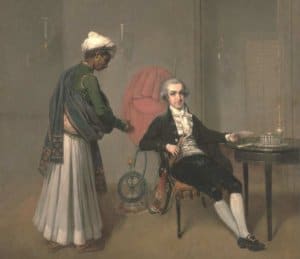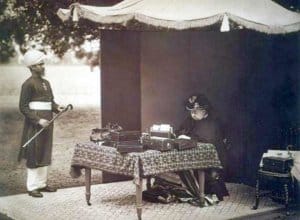英国的咖喱

英国现在每年10月都会庆祝全国咖喱周。 虽然咖喱是一道根据英国人口味修改的印度菜,但它如此受欢迎,对英国经济的贡献超过50亿英镑。 因此,当2001年英国外交大臣罗宾-库克将Chicken Tikka Masala称为 "真正的英国国菜 "时,这并不令人惊讶。
如果说英国教会了印度如何打板球,那么印度也许通过教会英国人如何享受热腾腾的印度咖喱来回报他们。 到了18世纪,东印度公司的人(俗称 "nabobs",是印度语 "nawab "的英语变形,意思是总督或总督)回到家里,想要重现他们在印度度过的一段时光。 那些没钱带回来的人他们的印度厨师在咖啡馆里满足了他们的胃口。 早在1733年,Haymarket的Norris Street咖啡馆就供应咖喱。 到1784年,咖喱和米饭已经成为伦敦皮卡迪利周围地区一些受欢迎的餐馆的特色菜。
 一位东印度公司的官员在享用钩镰枪(在印度)。
一位东印度公司的官员在享用钩镰枪(在印度)。
第一本包含印度菜谱的英国烹饪书是汉娜-格拉斯的 "The Art of Cookery Made Plain & Easy"。 1747年出版的第一版有三份印度皮劳的菜谱。 后来的版本包括鸡肉或兔肉咖喱和印度泡菜的菜谱。
 摘自汉娜-格拉斯的《简单明了的烹饪艺术》第一家纯印度餐馆是Hindoostanee咖啡馆,于1810年在梅菲尔区波特曼广场附近的乔治街34号开业。 该餐馆的老板萨凯-迪恩-马哈默德是个迷人的人物。 马哈默德于1759年出生于今天的巴特那,当时属于孟加拉总统府,曾在东德军队中服役。他后来与 "他最好的朋友 "戈弗雷-埃文-贝克上尉一起去了英国,甚至还娶了一个爱尔兰女人。 在他的咖啡馆里,穆罕默德试图提供正宗的氛围和 "最完美的 "印度美食。 客人可以坐在定制的竹蔗椅上,周围是印度场景的绘画,享受 "被允许的 "美食。还有一个单独的吸烟室供水烟使用。
摘自汉娜-格拉斯的《简单明了的烹饪艺术》第一家纯印度餐馆是Hindoostanee咖啡馆,于1810年在梅菲尔区波特曼广场附近的乔治街34号开业。 该餐馆的老板萨凯-迪恩-马哈默德是个迷人的人物。 马哈默德于1759年出生于今天的巴特那,当时属于孟加拉总统府,曾在东德军队中服役。他后来与 "他最好的朋友 "戈弗雷-埃文-贝克上尉一起去了英国,甚至还娶了一个爱尔兰女人。 在他的咖啡馆里,穆罕默德试图提供正宗的氛围和 "最完美的 "印度美食。 客人可以坐在定制的竹蔗椅上,周围是印度场景的绘画,享受 "被允许的 "美食。还有一个单独的吸烟室供水烟使用。
 绅士(可能是威廉-希基)和印第安仆人的肖像》,作者是阿瑟-威廉-德维斯,1785年
绅士(可能是威廉-希基)和印第安仆人的肖像》,作者是阿瑟-威廉-德维斯,1785年
该餐厅的主要顾客之一是查尔斯-斯图尔特(Charles Stuart),因其对印度和印度教文化的迷恋而被称为 "印度教斯图尔特"。 然而,不幸的是,该企业并不成功,两年内迪安-穆罕默德就申请了破产。 它很难与其他更成熟、更靠近伦敦的咖喱店竞争。 此外,很可能是那些小混混们波特曼广场附近的居民有能力雇佣印度厨师,因此没有太多必要出去品尝印度菜。
Lizzie Collingham在她的《咖喱:厨师和征服者的故事》一书中认为,英国人对咖喱的喜爱是由于英国烹饪的平淡无奇。 热辣的印度咖喱是一种受欢迎的变化。 在威廉-萨克雷的讽刺小说《名利场》中,主人公丽贝卡(又称贝基-夏普)对辣椒和胡椒的反应表明英国人对辛辣食物是多么的陌生:
"给夏普小姐来点咖喱,亲爱的,"塞德利先生笑着说。丽贝卡以前从未尝过这道菜........。"哦,太好了!"丽贝卡说,她正遭受着辣椒的折磨。"用它试试辣椒,夏普小姐,"约瑟夫说,真的很感兴趣。"辣椒,"丽贝卡说,喘着气。"哦,对!"她认为辣椒是一种很酷的东西,正如其名称进口....... "它们看起来多么新鲜和绿色,"她说,并把一个放进她的嘴里。这比咖喱还热...........。"水,看在上帝的份上,水!"她喊道。
到19世纪40年代,印度产品的销售商试图用咖喱的饮食益处来说服英国公众。 据他们说,咖喱有助于消化,同时刺激胃部,从而促进血液循环,使人更有活力。 咖喱还作为一种使用冷肉的绝佳方式而受到欢迎。 事实上,咖喱冷肉是jalfrezi的起源,现在是一种在1820年至1840年期间,英国的姜黄(制作咖喱的主要成分)进口量增加了三倍。
 鸡肉馅饼
鸡肉馅饼
然而,1857年的血腥起义改变了英国人对印度的态度。 英国人被禁止穿印度服装;最近受过教育的公职人员贬低那些已经成为当地人的老公司人员。 咖喱也 "失去了种姓",在时尚餐桌上变得不那么受欢迎,但在军队食堂、俱乐部和普通平民的家里,主要在午餐时提供。
咖喱需要一个冲击,谁能比女王本人更适合推广它呢? 维多利亚女王对印度特别着迷。 她对印度的兴趣可以在奥斯本宫看到,她和丈夫阿尔伯特亲王在1845年至1851年期间建造了奥斯本宫。 在这里,她在一个特别设计的侧翼收集印度的家具、绘画和物品。 杜巴室(最初委托建造为女王在1890年建造了一个奢华的印度餐厅),用白色和金色的石膏板装饰成花朵和孔雀的形状。
维多利亚雇用了印度仆人,其中一个24岁的阿卜杜勒-卡里姆(Abdul Karim),被称为 "Munshi",成为她 "最亲密的朋友"。 据维多利亚的传记作者A.N. Wilson说,卡里姆用咖喱鸡配豆类和皮劳给这位君主留下了深刻印象。 据说后来她的孙子乔治五世除了对咖喱和孟买鸭子感兴趣外,对任何食物都没有兴趣。
See_also: 英语礼仪 1893年,维多利亚女王和文士号
1893年,维多利亚女王和文士号
到20世纪初,英国已成为约7万名南亚人的家园,他们主要是仆人、学生和前海员。 伦敦出现了一些印度餐馆,最著名的是霍尔本的Salut-e-Hind和杰拉德街的Shafi。 1926年,Veeraswamy在摄政街99号开业,这是首都第一家高端印度餐馆。 其创始人Edward Palmer属于爱德华的曾祖父威廉-帕尔默(William Palmer)是东印度公司的一名将军,与莫卧儿公主Begum Fyze Baksh结婚。 帕尔默的餐厅成功地捕捉到了拉吉王朝的氛围;著名的客户包括威尔士王子(后来的爱德华八世)、温斯顿-丘吉尔和查理-卓别林,等等。
咖喱还没有在英国美食中站稳脚跟。 在20世纪40年代和50年代,伦敦的大多数主要印度餐馆都雇用了来自孟加拉国的前海员,特别是来自锡赫勒的海员。 这些海员中的许多人都渴望开一家自己的餐馆。 第二次世界大战后,他们购买了被炸毁的薯条店和咖啡馆,将咖喱和米饭与鱼、馅饼和薯条一起出售。 他们在第二次世界大战后仍然营业。晚上11点,为了抓住酒后交易的机会,在酒吧过夜后吃热咖喱成为一种传统。 随着顾客越来越喜欢吃咖喱,这些餐馆抛弃了英国菜,变成了廉价的印度外卖和餐馆。
 马萨拉鸡肉,英国最受欢迎的咖喱饭
马萨拉鸡肉,英国最受欢迎的咖喱饭
1971年后,大量孟加拉移民涌入英国。 许多人进入了餐饮业。 根据全国咖喱周的共同创始人彼得-格罗夫斯的说法,英国 "65%-75%的印度餐馆 "是由孟加拉移民拥有。
今天,大伦敦地区的印度餐馆比德里和孟买的总和还要多。 正如罗宾-库克恰如其分地说,咖喱在全国的流行是 "英国吸收和适应外部影响方式的完美说明"。
作者:Debabrata Mukherjee 我是著名的印度管理学院(IIM)的MBA毕业生,目前在Cognizant商业咨询公司担任顾问。 厌倦了平凡的公司生活,我求助于我的第一爱好--历史。 通过我的写作,我想让历史变得有趣,让别人也喜欢。

